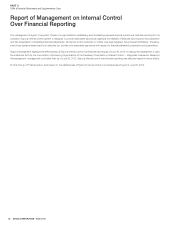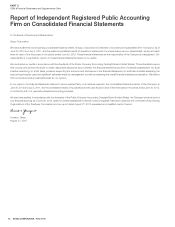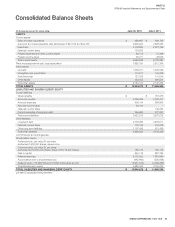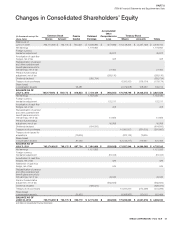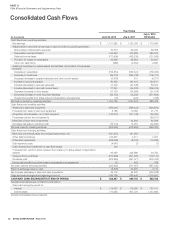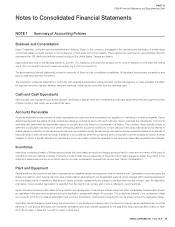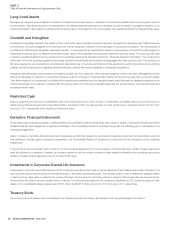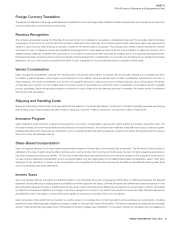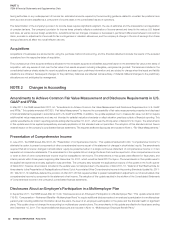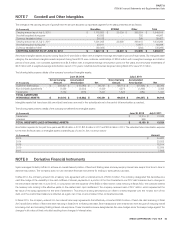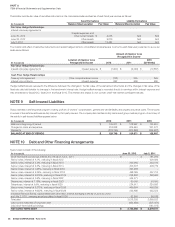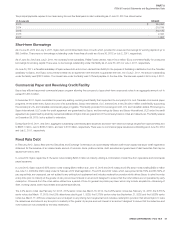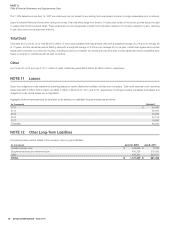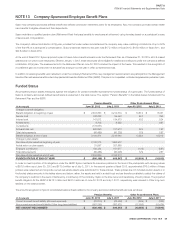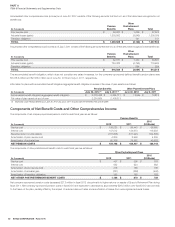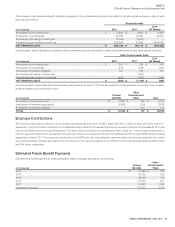Sysco 2012 Annual Report Download - page 75
Download and view the complete annual report
Please find page 75 of the 2012 Sysco annual report below. You can navigate through the pages in the report by either clicking on the pages listed below, or by using the keyword search tool below to find specific information within the annual report.
SYSCO CORPORATION-Form10-K52
PARTII
ITEM8Financial Statements and Supplementary Data
taxing authorities on any underpayment of income tax, estimated amounts required by the accounting guidance related to uncertain tax positions have
been accrued and are classifi ed as a component of income taxes in the consolidated results of operations.
The determination of the company’s provision for income taxes requires signifi cant judgment, the use of estimates and the interpretation and application
of complex tax laws. The company’s provision for income taxes primarily refl ects a combination of income earned and taxed in the various U.S. federal
and state, as well as various foreign jurisdictions. Jurisdictional tax law changes, increases or decreases in permanent differences between book and tax
items, accruals or adjustments of accruals for tax contingencies or valuation allowances, and the company’s change in the mix of earnings from these
taxing jurisdictions all affect the overall effective tax rate.
Acquisitions
Acquisitions of businesses are accounted for using the purchase method of accounting, and the fi nancial statements include the results of the acquired
operations from the respective dates of acquisition.
The purchase price of the acquired entities is allocated to the net assets acquired and liabilities assumed based on the estimated fair value at the dates of
acquisition, with any excess of cost over the fair value of net assets acquired, including intangibles, recognized as goodwill. The balances included in the
consolidated balance sheets related to recent acquisitions are based upon preliminary information and are subject to change when fi nal asset and liability
valuations are obtained. Subsequent changes to the preliminary balances are refl ected retrospectively, if material. Material changes to the preliminary
allocations are not anticipated by management.
NOTE2 Changes in Accounting
Amendments to Achieve Common Fair Value Measurement and Disclosure Requirements in U.S.
GAAP and IFRSs
In May2011, the FASB issued ASU 2011-04, “Amendments to Achieve Common Fair Value Measurement and Disclosure Requirements in U.S. GAAP
and IFRSs.” This update amended ASC 820, “Fair Value Measurement” to improve the comparability of fair value measurements presented and disclosed
in fi nancial statements prepared in accordance with U.S. GAAP and IFRSs. In addition, the update explained how to measure fair value, but did not require
additional fair value measurements and was not intended to establish valuation standards or affect valuation practices outside of fi nancial reporting. This
update was effective for interim reporting periods ending after December15,2011, which was the third quarter of fi scal 2012 for Sysco. The amendments
in this update were to be applied prospectively and early application of this standard was not permitted. The adoption of this standard did not have a
material impact on the company’s consolidated fi nancial statements. The required additional disclosures are included in Note4, “Fair Value Measurements.”
Presentation of Comprehensive Income
In June2011, the FASB issued ASU 2011-05, “Presentation of Comprehensive Income.” This update amended ASC 220, “Comprehensive Income” to
eliminate the option to present components of other comprehensive income as part of the statement of changes in stockholders’ equity. The amendments
required that all nonowner changes in stockholders’ equity be presented either in a single continuous statement of comprehensive income or in two
separate but consecutive statements. The amendments in this update did not change the items that must be reported in other comprehensive income
or when an item of other comprehensive income must be reclassifi ed to net income. The amendments in this update were effective for fi scal years, and
interim periods within those years, beginning after December15,2011, which would be fi scal 2013 for Sysco. The amendments in this update were to
be applied retrospectively and early application was permitted. The company early adopted the applicable provisions of this update in the fourth quarter
of fi scal 2012; however, all provisions included in the update were not adopted due to the issuance of ASU 2011-12, “Deferral of the Effective Date for
Amendments to the Presentation of Reclassifi cations of Items Out of Accumulated Other Comprehensive Income in Accounting Standards Update No.2011-
05.” ASU 2011-12 indefi nitely deferred the provision of ASU 2011-05 that required entities to present reclassifi cation adjustments out of accumulated other
comprehensive income by component in the statement of net income. The adoption of this update resulted in the addition of the Consolidated Statements
of Comprehensive Income in the company’s consolidated fi nancial statements.
Disclosures About an Employer’s Participation in a Multiemployer Plan
In September2011, the FASB issued ASU 2011-09, “Disclosures about an Employer’s Participation in a Multiemployer Plan.” This update amends ASC
715-80, “Compensation—Retirement Benefi ts—Multiemployer Plans” to require additional disclosures about an employer’s participation in a multiemployer
pension plan including additional information about the plans, the level of an employer’s participation in the plans and the fi nancial health of signifi cant
plans. This update does not change the accounting for multiemployer pension plans. The amendments in this update are effective for fi scal years ending
after December15,2011. The required additional disclosures are included in Note14, “Multiemployer Employee Benefi t Plans.”


